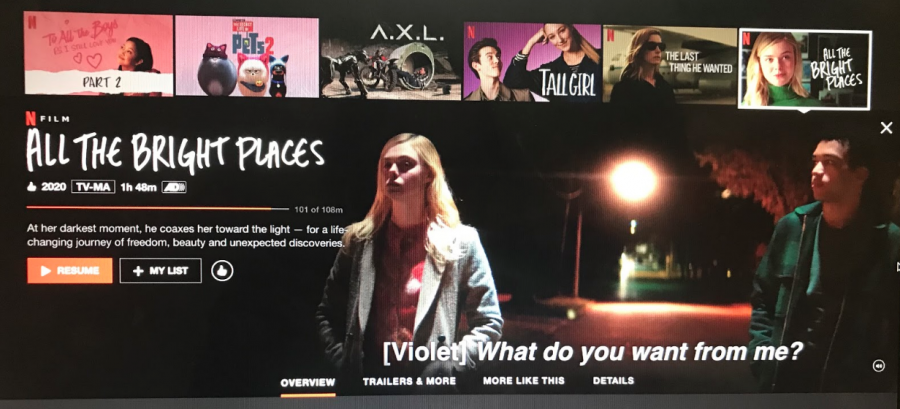‘All the Bright Places’ creates a compelling journey for teens
Graphic by Lyah Muktavaram ’22
‘All the Bright Places,’ based off of Jennifer Niven’s young adult novel, was released on Feb. 28 on Netflix and takes viewers on a compelling journey.
Suicide, death, heartbreak are all themes that I usually avoid when watching a movie. However, I found myself quickly addicted to Netflix’s “All the Bright Places.”
Based on the young adult fiction novel by Jennifer Niven, “All the Bright Places” takes a powerful approach to mature themes, including heartbreak and suicide. The movie is centered around the lives of two teenagers who struggle to deal with their emotional pasts. Nevertheless, when they meet, they weave together a compelling and alluring story.
The movie follows the life of Violet Markey (Elle Fanning) and Theodore Finch (Justice Smith) as they strive to overcome death and heartbreak.
After their initial meeting, the pair end up doing a school project together during which they were assigned to travel around their home state, Indiana, and report on any unusual or interesting sights, which only continues to bring them closer together.
The movie did a stellar job introducing the mature theme of death while still keeping me engaged. For example, the movie introduced the theme of death by exploring how Violet was impacted by her older sister’s unexpected death. While Violet was dramatically affected by the death, the movie was able to show how she was able to come to terms with the event and become a stronger person, as a result.
Especially since this theme can be prominent in many teenagers’ lives, showing how an individual can change and become strong regardless of the circumstances can be important.
Furthermore, the movie is not only able to establish incredibly likable characters that you can’t help but root for, but it also creates emotional problems that strengthen the viewer’s connection with these characters. I especially enjoyed watching the emotional character development Violet makes after meeting Theodore as she moves from a closed-off and secluded character to a cheerful young woman.
As the movie progressed, it remained engaging and compelling due to the fact that Theodore and Violet’s relationship grew. As it continued, I found myself getting more and more invested in the high school and personal issues the two of them faced.
Especially as Theodore’s bipolar disorder started to create some division between the two characters, my emotional investment in the movie furthered. The disorder essentially causes Theodore to separate himself from Violet, spending more time apart from her. As I started to get more comfortable watching these characters, this emotional separation forced me to truly empathize and feel for Violet and Theodore.
Between the likable characters and the emotional problems that faced, I realized that the movie truly made it seem like I was directly able to experience the emotions and heartache that Violet and Theodore faced, continuing to draw me in minute after minute.
This emotional transition failed to disappoint as it addressed mature and prevalent themes for teenagers across the country.
Rating: ★ ★ ★ ★ ★ (five out of five)

Broadcast Director Lyah Muktavaram ’22 stays busy as part of Inklings and as a Staples girls’ cross country captain. This is her third year writing...



























































